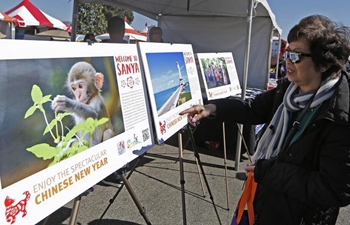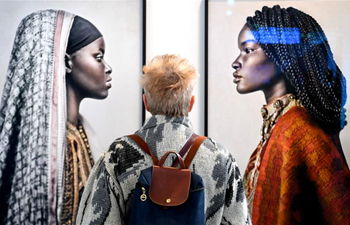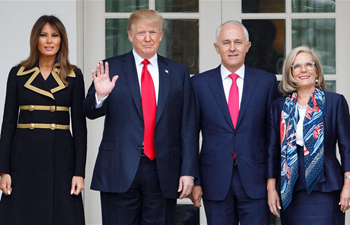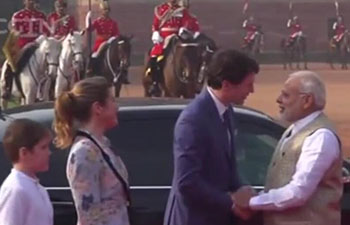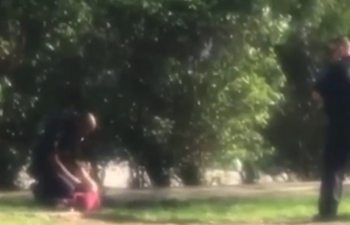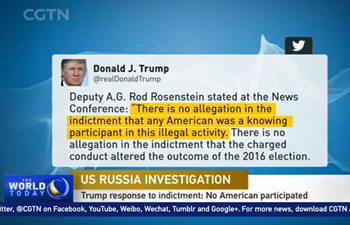By Julia Pierrepont III
ALHAMBRA, the United States, Feb. 24 (Xinhua) -- "I have lived here long enough to say that the fact we are celebrating Chinese New Year in a U.S. city speaks volumes about the racial harmony here," Felix Guo, KAZN AM 1300 and KAHZ AM 1600's popular radio announcer told Xinhua.
Guo kicked off the proceedings as the official Master of Ceremonies from a stage decorated with red Chinese lanterns and inflatable dogs Saturday, at the annual Alhambra Chinese New Year Festival.
Born in China but now a nationalized U.S. citizen, Guo spoke from the heart, "I am proud of my Chinese heritage ...." He addressed a crowd of 25,000 people - local families with strollers, grandparents, couples, business people and the curious - who had all turned out to celebrate the Lunar New Year.
The annual celebration is an important cultural event that the city of Alhambra has been hosting for the last 27 years. Originally launched by the city's Chamber of Commerce, the event was designed to create a bridge between Chinese and American cultures and to share the Chinese community's rich cultural heritage with their American neighbors.
It has been an effective cross-cultural event since its inception, according to Alhambra's Mayor Stephen Sham.
"It shows the people and community that we are part of the fabric of America, and as representatives of the entire local community, we don't only celebrate the Chinese heritage, we celebrate all cultures here, Hispanic, American and many others."
Alhambra, located 20 kilometers east of downtown Los Angeles, has had a longstanding commitment to promoting cross-cultural cooperation and understanding.
With a population that is 53 percent Chinese, 43 percent Hispanic, 28 percent White, 1.5 percent African American, and slightly less than 1 percent Native American, the city is a poster child for diversity in America.
Mayor Sham, told Xinhua, "For a city this diverse to work together well, we need to understand each other by sharing our cultures, our heritage, and our way of daily life with each other."
As the honorary head of the event, he is proud of his city's accomplishments, "There has been the Golden Dragon parades for 100 years in LA and SF Chinatowns for over 100 years, but we are the first one in the Gabriel Valley to host a Chinese New Year festival. And look how successful it has grown to be."
The audience was entertained by a prancing pride of dancing lion puppets, then a troupe of young girls in traditional Chinese outfits who sang and danced to Chinese music, and a happy passel of 'puppies', really young boys in doggie costumes, to commemorate the Year of the Dog.
Said Congresswoman, Judy Chu, the first Chinese women ever elected to Congress, "The Year of the Dog signifies loyalty, honesty and responsibility. And what a great sight I see before me - all these people here to celebrate Chinese New Year - stretching as far as the eye can see."
One of the attendees is 85 year-old, Darleen Petersen, a long time Alhambra resident who has been coming to the festival for decades. "I've always loved Chinese art and culture. It's so elegant and different. This festival is part of how I stay connected to it."
Taking place along Valley Boulevard in the heart of Alhambra, four city blocks were cordoned off to traffic, open only to pedestrians. The street was transformed into an elbow-to-elbow Chinese market where thousands of people from all walks of life, all races and cultural backgrounds learned a little bit more about Chinese culture and shopped to their hearts content amongst the hundred or so booths that lined the street.
Like an exotic Asian bazaar, shoppers could find almost anything there: tantalizing Chinese spices, packets of Goji berries and dried Shitake mushrooms sitting next to high end skin lotions, luxury cars, high tech Karaoke sound systems, fine silk scarves and women' s wear, while across the way were healthcare and Medicare booths, Welles Fargo bank' s famous stagecoach, plus a combat Humvee, and dozens of booths selling mini-bikes, toys, jewelry and trinkets of all kinds.
Moreover, another attractive booth displayed stunning photographs of Sanya, a city in China that has been the Official Sister City to Alhambra for decades.
"Sanya? Where is Sanya?" a festival goer asked. "It's our Sister City," Mayor Sham told Xinhua.
Many attendees asked the mayor the same question. Standing in the Sanya booth, wearing a festive red scarf, he gave them the standard answer, "Sanya is a lovely coastal city on a tropical island off the coast of Southeast China that many compare to Hawaii." That, everyone understood at once.
Sanya is an unspoiled corner of the world and a popular vacation destination for discerning travelers and eco-tourists who want to get off the beaten track without sacrificing luxury and comfort.
Mayor Sham called Sanya "a paradise" with spectacular scenery, pristine beaches, and exotic tribal dancers. "It's changed so much in the years since Alhambra Sistered with them. Now it also has many luxury hotels, high-end spas and sites of cultural interest." John, a 40 year-old American designer, stayed in the booth for almost a half hour, looking at the photo gallery of exquisite pictures, one by one.
"I never knew we had a Sister City like Sanya," he told Xinhua, "I see the beautiful scenery, the white beaches, the amazing looking food, luxury hotels and the cute monkies... I've been to China three times, in Beijing and Shanghai, but Sanya is a totally different style."
Said Jane Webster of Pasadena,"I'd love to go there. It looks so beautiful and peaceful."







